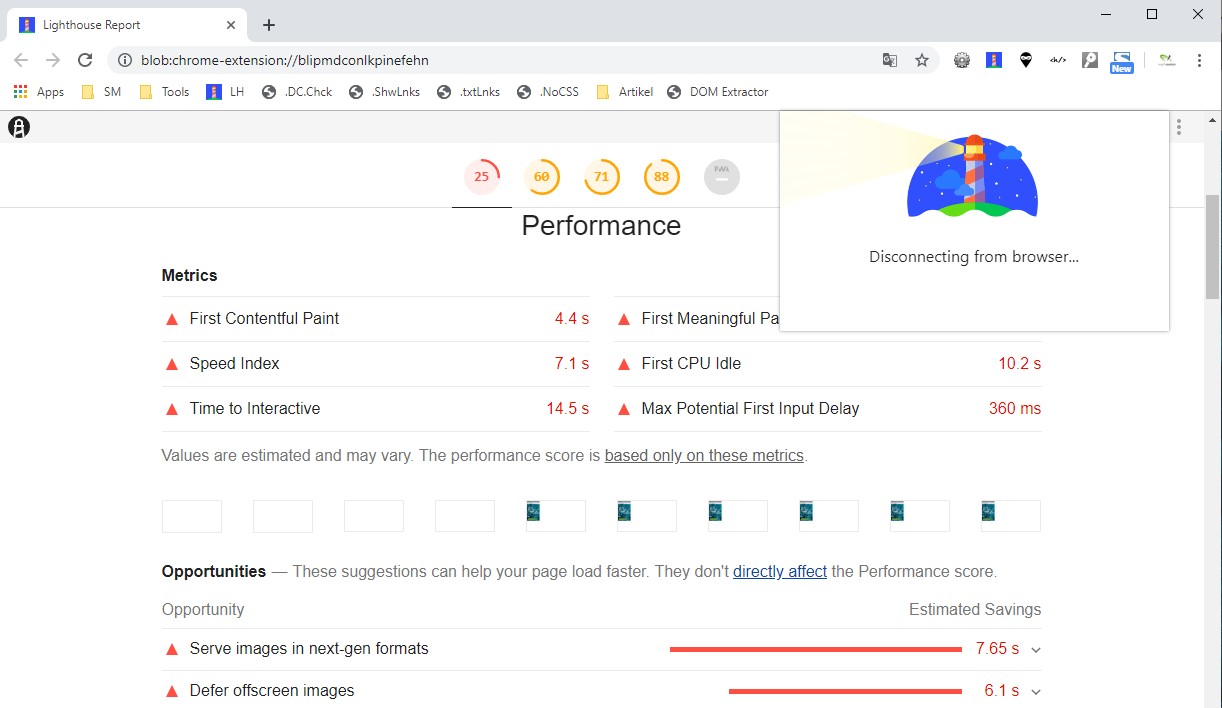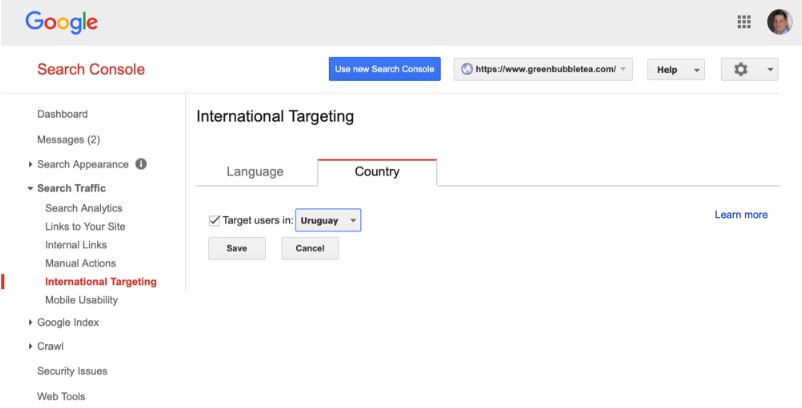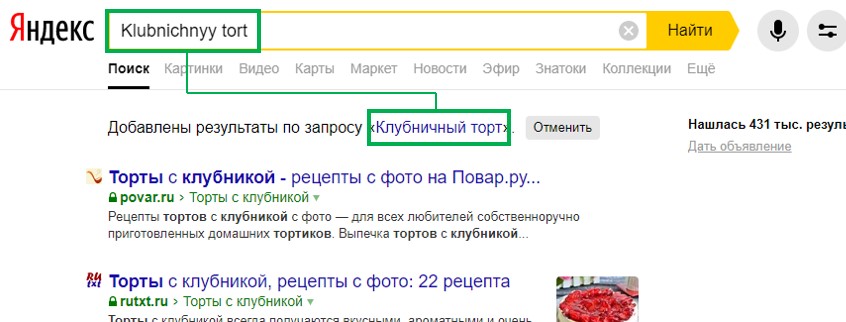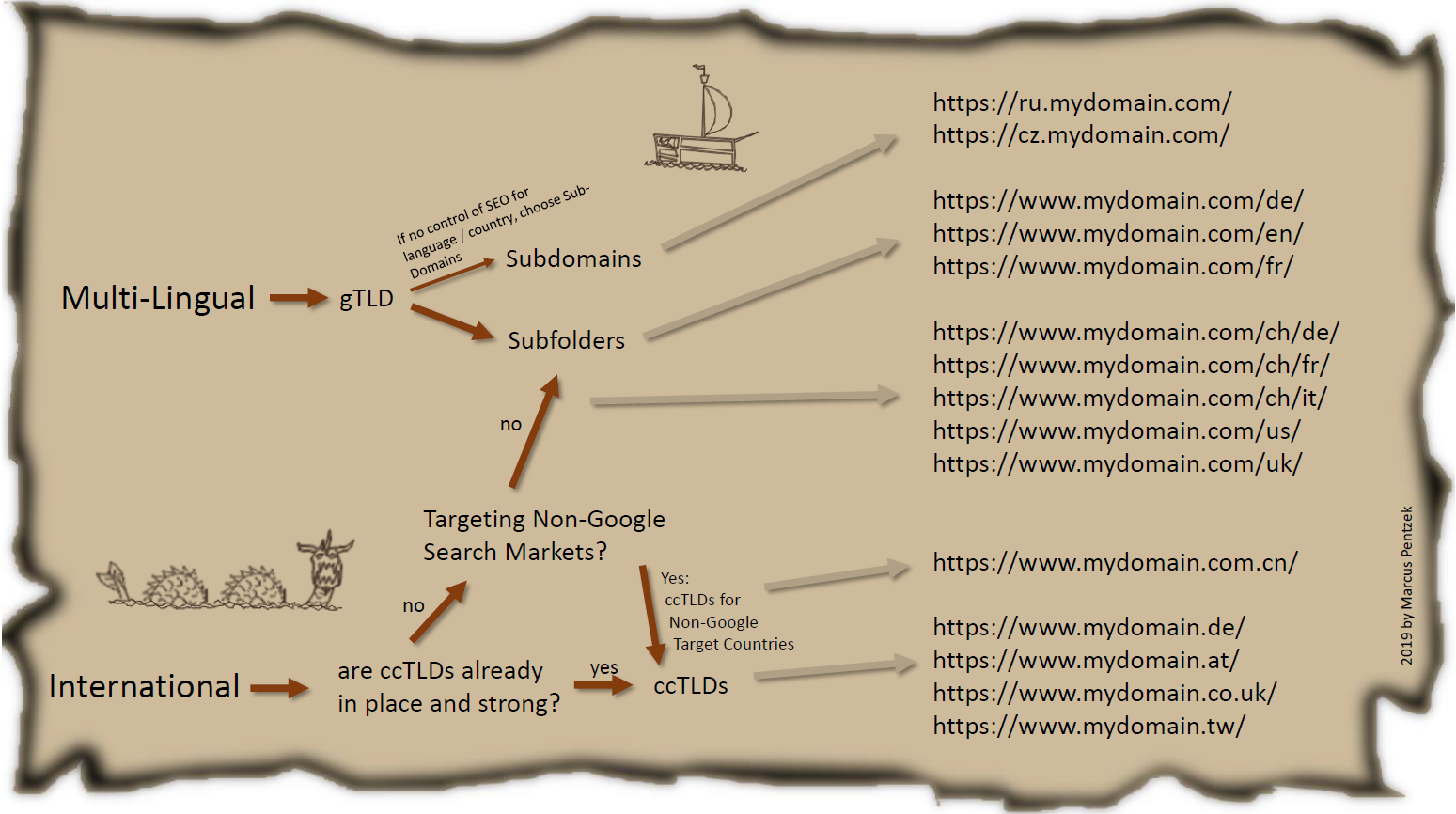The notion of search engine optimization in one country or in one language can rarely be squared with the realities facing companies today. Most businesses want to reach people across the globe and sell to customers in many different countries. This won’t normally be possible if the company is limited to a local (e.g. German, French or Spanish) website. To successfully navigate the seven seas of search, you need to understand Baidu, Yandex and Bing, and understand the requirements of different languages and regions. And remember, you are not just trying to be understood – you are trying to be found by your target audience.
If you’d like support in your international SEO efforts, then you can make an appointment with our Digital Strategies Group experts and see how they can help:
The seven seas of search
Just as the world’s different oceans and seas – the Atlantic, the Black Sea, the Arctic Ocean or the Dead Sea – all differ in terms of their flora and fauna, the people that sail them and the minerals in their water, so too is the world home to numerous different organic search environments:
- In Europe, you are primarily sailing through Google waters.
- In North America, the environment is a mixture of Google and Bing, with the predominant force dependent on the industry.
- If we traverse the Pacific Ocean, we reach Japan, where Yahoo was traditionally the dominant search engine (although note that in Japan Yahoo was served by the Google Index, not the Bing Index as it is in the rest of the world), but modern Japan is largely Google territory.
- In South Korea we find the national search engines, Daum and Naver, but Google is also important here.
- Google is a non-entity in China, where Baidu rules the waves, together with a few smaller competitors like 360search (so.com) or the mobile app, Shenma.
- Russia is another country that isn’t (only) ruled by Google. Half of the search engine market in Russia belongs to Yandex, though the division isn’t along regional lines – there is a mixture of Google and Yandex throughout the country.
- This brings us back to Europe, entirely occupied by Google. Well, not entirely…One small enclave of indomitable Gauls (or rather Slavs) still holds out against the invaders. Many users in Czechia prefer the search engine “Seznam” to Google.

This round-the-world trip shows that international search engine optimization is far more diverse than just Google. Google’s search engine is highly capable and Google understands and “speaks” many different languages, but Google is by no means the only search engine out there. This means that for a web-vessel to sail the seven seas of search, it must be built to be seaworthy in other waters.
Building a vessel for the world’s oceans
If we stick to our nautical analogy, then our websites are the vessels that have to sail the seas of search. Not every ship will be equally suited to every water. The Google oceans are rich with the salt of sophisticated technology, developed by Google’s skilled engineers, meaning that web-vessels can sail here even if they have HTML gaps and/or are laden with a heavy cargo (the increased salt/tech levels mean that Google can better support heavy, JavaScript-based websites). But not all the oceans are ruled by Google. A website that has successfully sailed through the calm seas of Europe may suddenly run aground in China (or Czechia). Baidu (and Seznam) have enough excellent websites to choose from that are unburdened by JavaScript, so they don’t have any need to invest resources in enhancing the capabilities of their crawlers to support this technology.
The materials you need to get your web-vessel shipshape
If you are planning to take your website out on the high seas of the world, then it is advisable to go with the lowest common denominators in terms of the material used to build your web-vessel – that means using the technology that every search engine will understand perfectly: HTML. More specifically, we can assume that the standard HTML5, introduced with semantic updates in 2014, is the most suitable material for a website intended for multi-search deployment. Of course, we can’t necessarily assume that every search engine fully interprets the new semantic elements and their meaning. However, we can happily assume that the application of semantics won’t create any disadvantages.
JavaScript can also be used but it should not be needed for the website to look good, to be easily usable and, above all, to deliver all the content that is supposed to be found. Implementing structured data mark-up with schema.org via JSON-LD is a nice bonus that you should definitely include. It can be particularly useful when sailing through Google waters, even if it isn’t particularly relevant in other search seas.
The Lighthouse of Alexandria
Once you have your building materials in place, then you can use the search engines’ lighthouses to guide your websites for smoother, improved performance. In this context, lighthouses are the tools provided by search engines that help webmasters to optimize their websites. Besides Google Lighthouse, this includes the Google Search Console, Bing Webmaster Tools and Baidu Zhanzhang.

Source: Google Lighthouse Chrome Plugin
The Lighthouse of Google a multi-purpose tool that can also help to optimize websites for other search engines. This works because Google’s aim isn’t SEO per se, it’s the optimization of the web for the modern world, which can only benefit users in non-Google waters and won’t put websites at a disadvantage. There are a few exceptions. Google recommends using next-generation image formats, which may not be correctly recognized as images by all search engines.
International or multi-lingual crew?
How should a website be structured? Does the website need a completely separate section for each country? Or is it enough to divide the web-vessel up into different linguistic areas? Because most non-Google search engines (with the exception of Bing) are restricted to a specific country and based on one language, the language and country can be treated as the same issue. For this reason, this section will mainly focus on setting up a multi-lingual web-vessel to sail through Google waters.
Let’s start by looking at the languages used by Google. Google analyzes and indexes content in a language and ranks it for search queries that are made in that language. Google also tries to provide search results to users in a particular country that are not only in the appropriate language but that are tailored to the preferences of users in that country.
If Google, for example, cannot identify any particular geographic features in a piece of Spanish-language content, then it should be able to rank in Spain and South America and – for Spanish search queries – in the USA.
Choppy waters for Google’s GEO identification
If a website starts to offer content in the same language for different regions, then Google’s compass can become confused. If you have four pages for Spain, Mexico, Argentina and Hispanic USA that all say the same thing – possibly even using the exact same words – then you can scramble Google’s navigational systems and end up having the wrong geographic pages ranking in the wrong countries.
Google is aware of such confusion and has (as well as suggested technical solutions, which I will come to later) a clear recommendation: If your content isn’t different for different countries, then you don’t (!) have to make a separate page for every country.
If you have the same information for visitors, whether they are coming from Argentina or Spain, then you don’t have to – in fact you shouldn’t – create separate pages for each country. You just need one Spanish-language page. This is particularly true for websites offering informational content.
For an eCommerce website, the company systems often force webmasters to build different pages for different countries, as the country dictates the price, the required information, VAT, shipping costs and other conditions. Orders have to be processed by regional staff and different inventory management software systems have their own specific requirements.
Most eCommerce systems are unable to fulfill the requirements of managing different currencies and geographical situations on the same URL. It isn’t beyond the realm of technical possibility that cookie information could be used to display the correct currencies, prices, shipping costs etc., and that the shopping cart could be diverted to an eCommerce system relevant to the target market. This would run in the background and not be accessible by search engine crawlers.
For Google, the entire online shop would have to be presented in the relevant language, but the user in Argentina (based on cookie information or on the user’s manual selection of a location) should not be shown products that cannot be shipped to Argentina, just as they should receive all the content that is designed for Argentinian users.
Weathering Google’s GEO storm
If it’s not possible to provide a geo-specific offering, as is the case for most eCommerce websites, and if the systems require two or more versions of the website that use the same language, then Google’s first recommendation is to write unique texts for each version. This eliminates the possibility of any duplicate content issues arising.
A second step (particularly if providing unique text for each country that uses the same language is not possible), is the use of hreflang with geographical markup – this identifies the individual pages according to their language and country.

Source: https://support.google.com/webmasters/answer/189077?hl=en
To support the use of hreflang, it was possible (until recently) to define the relevant country targeting for different areas of a website (if it isn’t tied to a ccTLD – i.e. a country code Top Level Domain) in the “old” Google Search Console.

Source: Google Search Console (old version – not accessible any longer)
In theory, Google will index the different URLs with the same content in the same language, and then choose the relevant page to display in the search results, based on the geographical target market. This doesn’t always work perfectly but it is the best way of safely navigating through the stormy waters of Google’s GEO identification.
Clear, country-specific signals on the website are also useful. These include currencies, local telephone numbers and addresses, and country-specific spellings or vocabulary (think colour vs color). Offsite factors include the server location (being physically in the same country can create faster reaction times) or backlinks from websites that have a clear connection to the geographic target. This could be supported by sending press releases to local papers or journalists, or building partnerships/sponsorships with local sport clubs etc.
A nimble fleet or a mighty battleship? ccTLDs, subdirectories or subdomains?
What is the best way to set up a domain if you want to be able to take on all search engines and countries? If you are planning a website where you want the content to be unique for each country, then separation into country-specific websites is a good option. These could all be published on ccTLDs (e.g. .co.uk for UK, .ca for Canada etc.). This has the advantage of the national ccTLDs enjoying a high level of trust amongst users.
The disadvantage of ccTLDs is that you have to build up a strong backlink profile for each individual website, which can require a considerable amount of content marketing and press work – you don’t want to go against Google’s guidelines and buy/rent backlinks.
To reduce the workload, you can use a shared generic TLD like .com and structure the international websites in subdirectories. All backlinks that are received for the shared gTLD will benefit all other country websites that are based at the same gTLD.
Instead of subfolders, there is the option of setting up subdomains for each country. However, this has a similar disadvantage to the use of separate ccTLDs, because each subdomain is treated by Google more like an individual domain that as part of the same domain. However, there can be slight inheritance synergies between subdomains. These can be strengthened by intelligent internal linking, which is, of course, recommended whatever the domain structure.
Mutiny? Launch the Subdomain!
There is one situation in which having a subdomain can be useful for protecting the rest of the website. This is if you don’t have complete control over the SEO measures of your whole site, and you cannot gain control in the medium-term.
Let’s look at Russia as an example. Russia isn’t only Yandex country, it has a search market that is 50% Google, which would suggest that a subdirectory on a gTLD should make sense for the Russian website.
However, if the Russian branch of your company has control of the SEO measures for its website and entrusts its optimization to a dodgy SEO agency that builds up automated backlinks and adopts out-dated SEO strategies like creating landing pages for every imaginable variant of a certain keyword then this could lead to the website being penalized by a Google Update, wrecking not just the Russian site, but dragging down all other language subdirectories too. Disclaimer: I’m in no way suggesting that all Russian SEOs work like this – but in the past many backlink spammers were based in Russia, which is why I have chosen Russia as an example.
Launching a subdomain for the area of the website that you don’t have full control over (“not having full control” could also refer to a website sub-format like a forum, where user-generated content can lead to repetitive discussions) can have the advantage that a penalty will often be restricted to the subdomain. If need be, this subdomain could be completely deactivated, while the rest of the international site can stay afloat.
Custom builds for foreign waters
The apparent disadvantage of using separate ccTLDs or subdomains for each country can actually be an advantage for search engine optimization in non-Google territories, particularly for search engines that are specialized for one country.
For local search engines like Baidu, 360se, Naver, Daum or Yandex, a clear linguistic criterion is that the content on the website is provided in the correct language.
If you use country-specific subfolders because this would appear to be a stronger structure, then the proportion of foreign-language content on a domain will quickly become larger than would make sense for a website that was only looking to serve the target market.
As a result, a search engine like Baidu, as well as crawling the Chinese content, also has to battle its way through English and Spanish pages. This could give Baidu’s artificial intelligence systems the impression that the site offers an inferior negative experience.
It’s often better to assign websites their own ccTLDs, or at least subdomains, when targeting search markets where you are most interested in local search engines and Google is of secondary (or non-existent) importance. This sends signals to the search engines that, in spite of links to the other languages, you are offering a website with a clear linguistic focus that is only indirectly related to other languages.
Learn more about global SEO in this episode of our Voices of Search podcast.
Finding the right names for your ships
Like every ship, every URL needs a name. There are various naming conventions around the world, just as every linguistic culture has its own characteristics. But for URLs, one thing is true of all search engines of the world: they should be “speaking”. A speaking URL shows the search engine user, when they are still at the search results page, that they are in the right place. This supports the communication achieved by the other parts of the snippet like the Meta Title and the Meta Description.
A speaking URL can, if it includes non-standard characters like accented vowels or Chinese characters, quickly cause problems. Search engines are able to cope, but not all software will display the URLs correctly – often they are coded and appear as cryptic gibberish to human users:
- mydomain.de/schöne-umlaute.html
- mydomain.de/sch%C3%B6ne-umlaute.html
- mydomain.des/akzénte-in-urls.html
- mydomain.des/akz%C3%A9nte-in-urls.html
- mydomain.com/大家好.html
- mydomain.com/%E5%A4%A7%E5%AE%B6%E5%A5%BD.html
Computers don’t have a problem with this UTF8 encoding, but most people will be baffled attempting to decrypt URLs like this. Fortunately, there is a variant for almost every special character or symbol that consists simply of readable alphanumeric characters.
Here are a few examples of how words with special characters can be displayed using simple Latin characters:
- fußgängerübergänge = fussgaengeruebergaenge
- größenmaßstäbe = groessenmassstaebe
- größenordnungsmäßig = groessenordnungsmaessig
- caleçon = calecon
- canapé = canape
- château = chateau
- voilà = voila
- noël = noel
- l’aïeul = laieul
- mañana = manana
- быть = byt
- сказать = skazat
- который = kotoryy
- ยินดีต้อนรับ = yinditxnrab
- สวัสดี = swasdi
- ยินดีที่ได้รู้จัก = yindithidirucak
- 大家好 = dajiahao
- 电脑 = diannao
- 草莓蛋糕= caomeidangao
Using these Romanized variants ensures that the URLs are readable for humans, without creating issues for the search engines. They can interpret these spellings, as demonstrated by the following screenshots:


Yandex shows results for the Cyrillic version “Клубничный торт”.
Charting your way through the seven seas of search
Before sending a crew of web-designers and developers off on their voyage, where they should program a website (or even just choose a CMS/eCommerce system), you should set up a clear internationalization strategy. This strategy can help you plot the best course to be taken as you navigate the seas of search in the years ahead.
From my personal experience of over 10 years on the international seas of SEO, I have compiled the following navigational chart to help seafarers find the best route for their web-vessel:

If you’d like support in your international SEO efforts, then you can make an appointment with our Digital Strategies Group experts and see how they can help:
If you have any other questions or comments about international SEO, I’d love to here from you in the comments!
